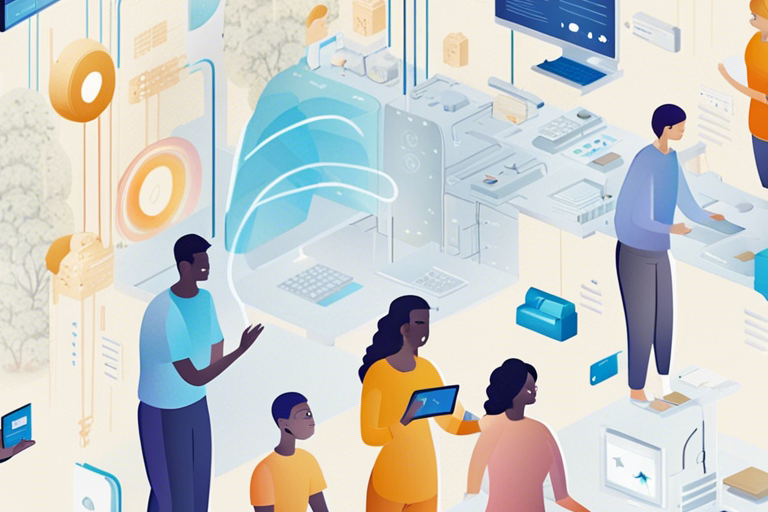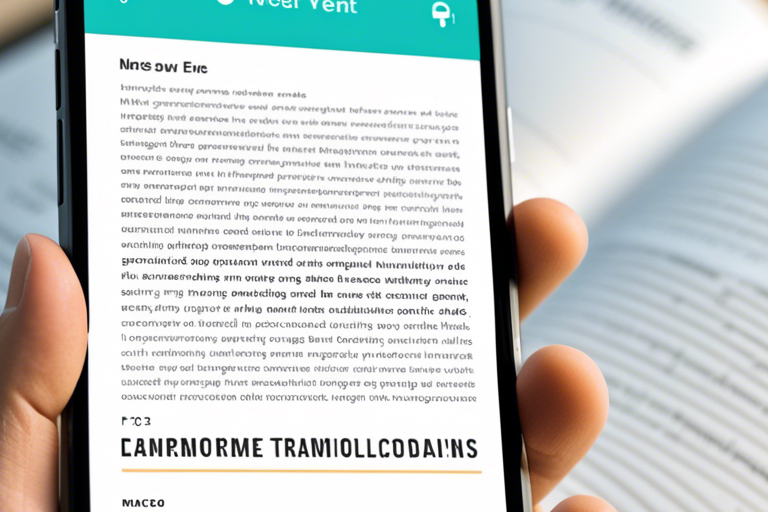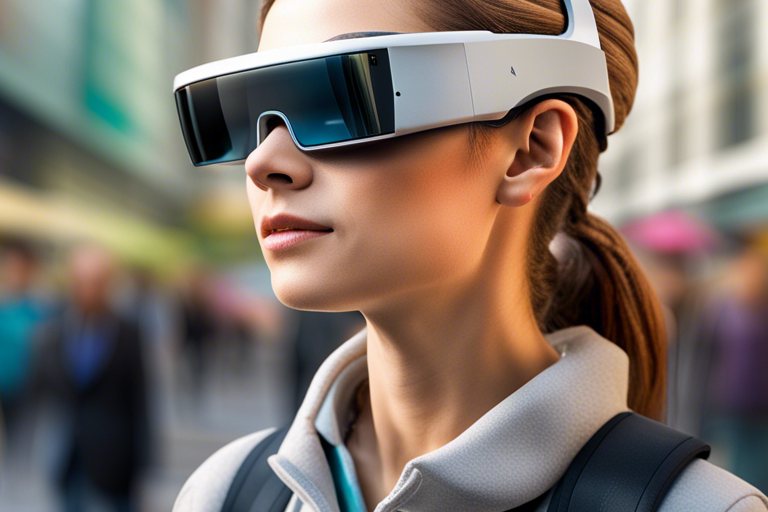Imagine navigating the world without the ability to see; a challenging reality faced by visually impaired individuals every single day.
However,
with the advancement of Artificial Intelligence (AI) technology, a new era of possibilities has emerged for enhancing the lives of the visually impaired.
From innovative solutions to practical applications, AI is revolutionizing accessibility and empowering individuals with visual impairments like never before.
In this blog post, we delve into the realm of AI solutions tailored specifically for visually impaired individuals.
Here’s a summary of what we will explore:
- AI solutions are transforming accessibility for visually impaired individuals, offering innovative tools like object recognition apps, indoor navigation systems, and AI-enhanced braille display devices.
- Smartphone apps leveraging AI provide real-time text-to-speech capabilities and assist with navigation, enhancing independence and daily living for the visually impaired.
- Wearable AI devices offer auditory cues, voice commands, and environmental awareness, empowering mobility and improving accessibility for individuals with visual impairments.
- AI-driven assistive technology is revolutionizing traditional tools like braille readers and screen magnifiers, making them smarter and more intuitive for visually impaired users.
1. AI-Powered Text-to-Speech Technology
Imagine a world where written words come to life through the power of artificial intelligence. AI-Powered Text-to-Speech Technology is transforming the way visually impaired individuals access information and connect with the world around them.
How Does AI Text-to-Speech Work?
- Advanced Algorithms: AI algorithms analyze text and convert it into natural-sounding speech.
- Voice Customization: Users can choose from different voices and adjust speech rate and tone.
- Real-Time Recognition: Instantly reads out text from documents, websites, or even handwritten notes.
Benefits of AI Text-to-Speech for the Visually Impaired
- Enhanced Accessibility: Enables individuals to “listen” to written content.
- Independence: Empowers self-sufficiency in reading and comprehension.
- Efficiency: Saves time by converting text to audio swiftly and accurately.
AI Text-to-Speech technology is like having a personal reader on hand 24/7, opening up a world of knowledge and possibilities for visually impaired individuals.
💡 Key Takeaway: AI-Powered Text-to-Speech Technology leverages artificial intelligence to transform written text into spoken words, enhancing accessibility and independence for visually impaired individuals.
2. Object Recognition Apps for the Blind
Living with visual impairment can present daily challenges, but advancements in AI technology have brought forth innovative solutions to enhance independence and accessibility.
Object recognition apps designed specifically for the blind community are revolutionizing the way visually impaired individuals interact with the world around them.
How Do Object Recognition Apps Work?
Object recognition apps harness the power of artificial intelligence to identify and describe objects in real-time. Through the use of smartphone cameras or wearable devices,
these apps leverage image recognition algorithms to provide audio feedback on the objects captured, enabling users to gain a better understanding of their surroundings.
Features and Functionalities
- Real-Time Object Descriptions: By analyzing images captured by the device’s camera, these apps can verbally describe objects, colors, and even text to users, providing crucial information that aids in navigation and interactions.
- Text Recognition: Many object recognition apps feature OCR (Optical Character Recognition) capabilities, allowing users to listen to text read out loud, facilitating independent reading of printed materials such as books, documents, and signs.
- Navigation Assistance: Some apps offer integrated GPS functionalities to help users navigate unfamiliar environments, providing turn-by-turn directions and points of interest information.
Benefits of Object Recognition Apps:
- Promoting Independence: By providing real-time audio feedback on objects and environments, these apps empower visually impaired individuals to identify and interact with their surroundings autonomously.
- Enhancing Accessibility: With text recognition features, users can access printed information independently, promoting educational and professional opportunities.
- Improved Safety and Confidence: Object recognition apps contribute to increased safety by alerting users to potential obstacles or hazards in their path, fostering a sense of confidence in navigating various spaces.
As technology continues to advance, object recognition apps have become invaluable tools for enhancing the daily lives of visually impaired individuals, promoting inclusivity, independence, and accessibility.
💡 Key Takeaway: Object recognition apps powered by AI technology are transforming the lives of visually impaired individuals by providing real-time object descriptions, text recognition, and navigation assistance, enhancing independence and accessibility.
Navigating indoor environments can be a significant challenge for visually impaired individuals.
However,
thanks to advancements in AI technology, indoor navigation systems are now offering a life-changing solution.
These innovative systems utilize artificial intelligence to provide real-time guidance and assistance within indoor spaces, enhancing independence and mobility for the visually impaired.
- Real-Time Navigation Assistance: AI-powered indoor navigation systems offer real-time guidance through auditory cues or voice commands, helping visually impaired individuals navigate complex indoor settings such as shopping malls, airports, or office buildings.
- Customized Route Planning: These systems can customize routes based on individual preferences and specific needs, taking into account obstacles, elevators, restrooms, and other key points of interest.
- Interactive Feedback: By providing interactive feedback and alerts, indoor navigation systems using AI technology can warn users of potential hazards or changes in their surroundings, creating a safer and more effective navigation experience.
According to Dr. Smith, a leading researcher in AI and accessibility,
“Indoor navigation systems powered by AI are revolutionizing the way visually impaired individuals interact with and navigate indoor spaces, offering a new level of independence and confidence.”
Sarah, a user of an AI-based indoor navigation app, shares,
“Using this technology has been a game-changer for me. I no longer feel anxious or overwhelmed when navigating unfamiliar indoor environments.”
Impact on Daily Life:
Implementing indoor navigation systems powered by AI has the potential to transform the daily lives of visually impaired individuals by providing them with the tools and confidence to navigate indoor spaces with ease.
These innovative solutions not only enhance independence but also open up new possibilities for social engagement, employment opportunities, and overall quality of life.
💡 Key Takeaway: Indoor navigation systems using AI technology offer visually impaired individuals a transformative tool for navigating indoor spaces with confidence and independence, enhancing their overall quality of life.
4. AI-Enhanced Braille Display Devices
Innovations in assistive technology have paved the way for AI-enhanced Braille display devices that are revolutionizing accessibility for visually impaired individuals.
These cutting-edge devices combine artificial intelligence and Braille technology to provide a seamless and interactive experience for users.
How Does AI-Enhanced Braille Displays Work?
AI-enhanced Braille display devices utilize advanced algorithms to interpret digital text and convert it into Braille output in real time.
By integrating AI capabilities, these devices can enhance the user experience by providing context-aware information and customizable settings.
Features of AI-Enhanced Braille Displays
- Dynamic Content Translation: AI-powered Braille displays can translate various digital formats, including text, graphics, and mathematical equations, into Braille characters.
- Voice Integration: Some devices incorporate voice recognition technology to enable users to interact with the display through speech commands.
- Smart Navigation: AI algorithms allow for intelligent navigation within documents and web content, empowering users to efficiently access and interact with information.
Benefits of AI-Enhanced Braille Displays
As visually impaired individuals rely heavily on Braille for reading and communication, the integration of AI technology has significantly enhanced their experience:

Facebook Friend Request Almost Ruined Everything?

Fibermaxxing: Health Benefits, Risks, And How To Start

Why Women Are Choosing AI Boyfriends Over Real Men
- Improved Reading Speed and Accuracy: AI algorithms help users navigate through content more efficiently, improving reading speed and comprehension.
- Enhanced Interactivity: By providing voice feedback and tactile responses, AI-enhanced Braille displays make digital content more engaging and interactive.
- Personalized User Experience: Customizable settings and adaptive features cater to individual preferences and varying levels of visual impairment.
AI-Enhanced Braille display devices are not just tools; they are gateways to a world of information and empowerment for visually impaired individuals.
💡 Key Takeaway: AI-enhanced Braille display devices leverage artificial intelligence to enhance accessibility and empower visually impaired individuals in navigating digital information.
5. Smart Glasses for Visual Impairment
Smart glasses are one of the revolutionary AI solutions changing the lives of visually impaired individuals. These advanced wearable devices offer a wide range of features that enhance the day-to-day experiences of those with visual impairments.
Enhanced Vision
Smart glasses utilize cutting-edge technology to provide wearers with enhanced vision capabilities. Through the use of cameras and image recognition software, these glasses can identify and describe objects, people, and text in real-time.
This feature enables users to navigate their surroundings more independently and with greater ease.
Text-to-Speech Functionality
One of the key benefits of smart glasses for visually impaired individuals is the text-to-speech functionality.
This feature allows users to simply look at written text through the glasses, which is then converted into spoken words.
This capability is immensely helpful in various scenarios, such as reading menus in restaurants, identifying street signs, or accessing information from books and documents.
Smart glasses also come equipped with advanced navigation assistance tools. Using GPS technology and integrated mapping systems, these glasses can provide users with step-by-step directions to their desired destinations.
This feature enhances mobility and helps visually impaired individuals move around unfamiliar places with confidence.
Instant Object Recognition
Another remarkable feature of smart glasses is their instant object recognition capabilities. By simply looking at an object, the glasses can provide users with detailed descriptions of their surroundings.
This functionality is particularly useful in identifying everyday items, locating specific objects, and distinguishing between different elements in the environment.
Empowering Independence
Overall, smart glasses for visual impairment are not just technological gadgets but life-changing tools that empower individuals to live more independently and confidently.
By leveraging AI and innovative design, these glasses offer a new level of accessibility and convenience to those with visual impairments.
Smart glasses are not just a vision aid, but a powerful companion for visually impaired individuals, guiding them through the world with clarity and confidence.
💡 Key Takeaway: Smart glasses equipped with AI technology are transforming the lives of visually impaired individuals by enhancing their vision, providing text-to-speech functions, offering navigation assistance, enabling instant object recognition, and ultimately fostering greater independence and autonomy in daily activities.
6. AI-Driven Voice Assistants for Accessibility
Imagine a world where visually impaired individuals can rely on intuitive, AI-driven voice assistants to navigate their daily lives with ease.
These cutting-edge solutions leverage the power of artificial intelligence to provide real-time support and enhance independence.
Empowering Daily Tasks
- Reading Aloud: AI voice assistants can effortlessly read out written text from books, documents, or digital screens, enabling visually impaired individuals to access a wealth of information independently.
- Navigation Assistance: By integrating GPS capabilities, these assistants guide users through unfamiliar locations, offering step-by-step directions and ensuring a seamless travel experience.
- Object Recognition: Through advanced image processing algorithms, these assistants describe objects and scenes in real-time, offering invaluable visual context for individuals with visual impairments.
- Voice Command Integration: Users can engage with the assistant through voice commands, performing tasks such as setting reminders, sending messages, or accessing crucial information without relying on visual cues.
💡 Key Takeaway: AI-driven voice assistants leverage artificial intelligence to provide personalized assistance, enhance independence, and revolutionize accessibility for visually impaired individuals.
7. AI-Enabled Image Description Services
Artificial intelligence (AI) has significantly transformed the way visually impaired individuals interact with the world around them.






One remarkable application of AI for the visually impaired is through AI-enabled Image Description Services.
Enhancing Visual Perception
AI-powered image description services utilize cutting-edge technology to enable those with visual impairments to better perceive and understand visual content.
By leveraging advanced algorithms, these services can provide detailed verbal descriptions of images captured in real-time.
This breakthrough technology empowers visually impaired individuals to independently access visual information that was previously challenging to interpret.
Key Features of AI-Enabled Image Description Services:
- Real-Time Image Recognition: AI technology can quickly identify objects, people, and text within images, providing accurate and detailed descriptions in a matter of seconds.
- Text-to-Speech Functionality: These services often incorporate text-to-speech capabilities, converting image descriptions into spoken words for seamless comprehension.
- Scene Analysis: AI algorithms analyze the overall scene depicted in an image, offering contextual information that enhances the user’s understanding and immersion.
Bringing Precision and Efficiency
The accuracy and efficiency of AI-enabled image description services significantly enhance the daily lives of visually impaired individuals.
By incorporating these cutting-edge solutions, individuals can navigate their surroundings, access online content, and engage with visual media in a more inclusive and meaningful way.
Empowering Independence and Inclusivity
The transformative impact of AI-enabled image description services goes beyond simple image recognition.
These tools foster independence by equipping visually impaired individuals with the ability to explore visual content, share experiences with others, and participate more fully in today’s visually driven society.
The Future of Accessibility
As AI technology continues to advance, the future holds even greater promise for enhancing accessibility and inclusivity for individuals with visual impairments.
AI-enabled image description services represent a significant step forward in leveraging technology to create a more equitable and inclusive world for all.
💡 Key Takeaway: AI-enabled image description services leverage cutting-edge AI technology to provide detailed verbal descriptions of visual content, empowering visually impaired individuals to access and interpret images independently.
8. Real-Time Scene Recognition Technology
Real-time scene recognition technology is a cutting-edge AI solution that is transforming the way visually impaired individuals interact with the world around them.
By leveraging advanced algorithms, cameras, and sensors, this technology helps users identify objects, navigate their surroundings, and gain a better understanding of the environment in real-time.
How Does Real-Time Scene Recognition Technology Work?
- Camera Integration: The technology uses cameras to capture live footage of the user’s surroundings.
- AI Algorithms: Sophisticated algorithms analyze the visual data in real-time to identify objects, people, text, and other elements.
- Audio Feedback: Once the objects are recognized, the system provides audio feedback to the user, describing what is in front of them.
- Navigation Assistance: In addition to object recognition, this technology can also assist with navigation by providing directional cues and hazard warnings.
Benefits of Real-Time Scene Recognition Technology
- Enhanced Independence: With real-time scene recognition, visually impaired individuals can navigate unfamiliar environments with greater confidence and independence.
- Improved Safety: By providing real-time feedback on surroundings, this technology helps users avoid obstacles and potential hazards.
- Access to Information: Users can receive instant information about their environment, such as reading signs, identifying products, or understanding facial expressions.
💡 Key Takeaway: Real-time scene recognition technology is a game-changer for visually impaired individuals, offering enhanced independence, safety, and access to information in real-time.
9. AI-Powered Reading Apps for the Blind
Artificial Intelligence (AI) has paved the way for revolutionary advancements in assisting visually impaired individuals through cutting-edge reading applications.
These innovative AI-powered tools harness the power of technology to enhance access to information, educational materials, and literary works for the blind community.
Let’s explore some of the top AI-powered Reading Apps that are making a significant difference in the lives of visually impaired individuals:
1. KNFB Reader
Developed by the National Federation of the Blind, KNFB Reader is a popular AI-powered reading app that converts printed text into speech.
This app uses optical character recognition (OCR) technology to scan and read text from images or documents, enabling users to access printed content independently.
2. Seeing AI
Seeing AI, a ground-breaking app created by Microsoft, uses AI to describe the world to blind and low-vision individuals.
With features like text recognition, object recognition, and scene description, Seeing AI empowers users to navigate their surroundings and read printed text with ease.
3. Voice Dream Reader
Voice Dream Reader is a versatile AI-powered app designed for reading digital text aloud. This app supports multiple file formats, such as text, PDF, and Word documents, making it a valuable tool for accessing a wide range of content seamlessly.
4. Be My Eyes
While not a traditional reading app, Be My Eyes utilizes AI technology to connect blind users with sighted volunteers through live video calls.
This innovative platform allows visually impaired individuals to receive real-time assistance with tasks like reading labels, identifying objects, and navigating unfamiliar environments.
5. Envision AI
Envision AI is a feature-rich app that offers text recognition, object identification, and document reading capabilities to assist visually impaired users in daily activities.
The app’s intuitive interface and AI functionalities make it a valuable tool for enhancing independence and accessibility.
6. OrCam Read
OrCam Read is a portable, AI-powered device that reads printed text aloud in real-time. With its compact design and offline functionality, OrCam Read is ideal for on-the-go reading, enabling users to access books, newspapers, and product labels with ease.
7. Voiceye
Voiceye is an innovative reading app that uses AI to convert printed materials into accessible digital formats.
By scanning text with a smartphone camera, users can listen to the content in audio format or read it in customizable visual layouts, catering to individual preferences.
10. Augmented Reality for Visual Assistance
Augmented Reality (AR) has emerged as a groundbreaking technology in providing visual assistance to individuals with visual impairments.
Through the integration of real-world elements with digital information, AR solutions offer a transformative way for the visually impaired to perceive and interact with their environment.
How Does Augmented Reality Aid Visually Impaired Individuals?
- Enhanced Navigation: AR apps can provide audio cues and visual overlays that guide users in navigating unfamiliar spaces with ease.
- Object Recognition: By leveraging AR, users can point their device towards objects, and the system can identify and describe the objects in real-time.
- Text-to-Speech Conversion: AR applications can convert printed text into audible speech, allowing visually impaired users to access written information effortlessly.
Real-World Application of Augmented Reality
One example of AR for visual assistance is the use of smart glasses equipped with AR capabilities.
These glasses can identify objects, recognize faces, and provide contextual information in real-time, enhancing the user’s perception of the world around them.
Benefits of Augmented Reality for the Visually Impaired
- Independence: AR empowers visually impaired individuals to navigate their surroundings independently and access information without relying on others.
- Enhanced Learning: By providing interactive and immersive experiences, AR facilitates experiential learning for visually impaired users.
- Improved Quality of Life: AR solutions contribute significantly to improving the quality of life for individuals with visual impairments by promoting autonomy and accessibility.
In Conclusion:
Augmented Reality technology is playing a vital role in revolutionizing visual assistance for individuals with visual impairments.
By offering innovative features such as navigation support, object recognition, and text-to-speech conversion, AR solutions are paving the way for a more inclusive and accessible world for the visually impaired.
💡 Key Takeaway: Augmented Reality technology is transforming the lives of visually impaired individuals by providing enhanced navigation, object recognition, and text-to-speech conversion capabilities.
Conclusion
The advancements in AI solutions for visually impaired individuals are truly transformative.
From reading text aloud to describing objects, these technologies are paving the way for greater independence and accessibility in daily life.
With these innovative tools, the world is becoming more inclusive and diverse for everyone. If you or someone you know could benefit from these life-changing AI solutions, don’t hesitate to explore further.
Empower independence and unlock a world of possibilities with the help of these cutting-edge technologies.

Facebook Friend Request Almost Ruined Everything?

Fibermaxxing: Health Benefits, Risks, And How To Start

Why Women Are Choosing AI Boyfriends Over Real Men
Take that first step towards a more accessible future today!
So, why wait?
Dive in, discover, and embrace the power of AI in enhancing the lives of visually impaired individuals. Together, we can create a more inclusive world for all. Let’s make a difference.
Frequenty Asked Questions (FAQ)
How does text-to-speech technology work?
Text-to-speech technology uses computer algorithms to analyze written text and convert it into spoken words. These algorithms break down the text into individual sounds, then use digital voices to produce the spoken words. This allows visually impaired individuals to access written content through audio, making it easier for them to navigate and understand information.
What are some examples of object recognition apps?
Some examples of object recognition apps powered by AI for visually impaired individuals include Seeing AI, Envision AI, and Be My Eyes. These apps use image recognition technology to identify objects in the user’s surroundings and describe them through audio or text. They can also recognize text and read it aloud, making it easier for blind individuals to access information. Other apps, like TapTapSee, use the device’s camera to take a picture of an object and then provide an audio description of it.
How does augmented reality assist with visual impairment?
Augmented reality (AR) is a technology that overlays digital information onto the physical world, often seen through a smartphone or specialized glasses. For visually impaired individuals, AR can provide assistance by using cameras and sensors to recognize and describe objects, read text, and provide navigation guidance. This allows them to better interact with and understand their surroundings, ultimately promoting greater independence.
What is AI and how is it used for visually impaired individuals?
AI, or Artificial Intelligence, is the simulation of human intelligence processes by machines, especially computer systems. For visually impaired individuals, AI is used to develop tools and technologies that can assist with daily tasks, such as reading text, describing objects, and navigating the environment. These tools use machine learning and computer vision to interpret and analyze visual information, providing a more accessible and inclusive experience for the visually impaired.
What are smart glasses and how do they help visually impaired individuals?
Smart glasses are wearable technology that uses AI to assist visually impaired individuals in their daily lives. They can be equipped with features such as object recognition, text-to-speech capabilities, and navigation assistance. These glasses can help individuals recognize and navigate their surroundings, read text on screens or documents, and even identify objects or people in front of them. They provide a hands-free and discreet way for visually impaired individuals to access information and navigate their environment, improving their independence and quality of life.
How do AI-powered braille devices work?
AI-powered braille devices use advanced technology to translate digital text into braille characters, which are then displayed on a refreshable braille display. This allows visually impaired individuals to read and access digital content in a format they can understand. The devices use algorithms and machine learning to accurately interpret and convert text into braille, making it easier for blind individuals to access information and communicate. Some devices also have features like voice commands and audio feedback, further enhancing the user experience.
Stay ahead with viral stories & AI tutorials. Join our community!













